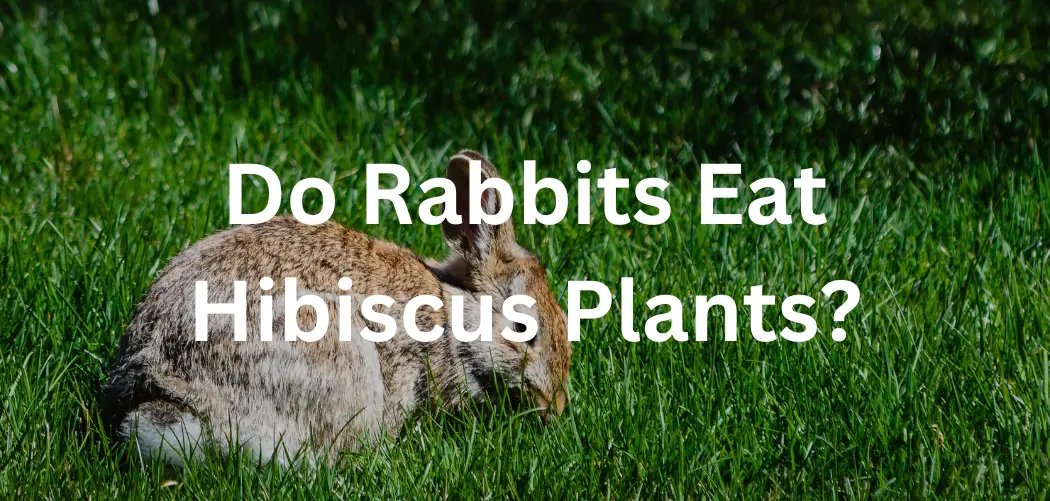We're an affiliate
We hope you love the products we recommend! Just so you know, we may collect a share of sales or other compensation from the links on this page. Thank you if you use our links, we really appreciate it!
Hibiscus plants are cherished for their vibrant, show-stopping blooms and lush foliage, making them a popular choice for gardens and landscapes. However, gardeners often face the concern of rabbits feasting on their beloved hibiscus plants. In this blog post, we will delve into the intriguing question of whether rabbits eat hibiscus plants and provide you with valuable insights on how to protect your cherished hibiscus from these furry visitors.
Rabbits are herbivores, meaning their diet consists primarily of plant matter. They have a wide-ranging appetite, consuming a variety of plants and vegetation. While rabbits typically target tender greens and young shoots, their preferences may vary depending on the region and availability of food sources. Common plants rabbits are known to eat include clover, grasses, lettuce, and many garden vegetables.
Table of Contents
Can Rabbits Eat Hibiscus Plants?
When it comes to hibiscus plants, rabbits may exhibit varying levels of interest. While some rabbits may nibble on hibiscus leaves and stems, it is generally not their preferred food source. The distinctively textured foliage of hibiscus plants, coupled with their somewhat bitter taste, often deters rabbits from devouring them entirely.
Several factors can influence rabbits’ preference for hibiscus plants. The availability of other food sources, such as more palatable plants, can affect their choice. Additionally, the presence of natural predators or other deterrents in the vicinity may discourage rabbits from targeting hibiscus plants.
Identifying Rabbit Damage on Hibiscus Plants
To determine whether rabbits have been snacking on your hibiscus plants, it is essential to recognize the telltale signs of rabbit damage. Look for cleanly clipped stems or partially eaten leaves. Rabbits tend to leave a clean, angled cut when feeding on plants, as opposed to the jagged or torn edges caused by other pests or environmental factors. Additionally, rabbit droppings may be present near the damaged plants, indicating their recent presence.
What happens to rabbits when eat hibiscus plants
When rabbits consume hibiscus plants, it can have both immediate and potential long-term effects on their health. Here are some things that can happen to rabbits when they eat hibiscus plants:
- Digestive Issues: Hibiscus plants contain a range of compounds, including tannins and fiber. Rabbits have sensitive digestive systems, and consuming large quantities of hibiscus foliage can lead to digestive disturbances such as diarrhea or gastrointestinal discomfort.
- Nutritional Imbalance: While rabbits can derive some nutrition from hibiscus plants, the plant’s composition may not provide all the essential nutrients required for a rabbit’s optimal health. Rabbits need a balanced diet that includes a variety of plant materials to meet their nutritional needs, including high-quality hay, fresh vegetables, and a small amount of pellets. Relying solely on hibiscus plants can result in a lack of essential nutrients and potential deficiencies.
- Toxicity Concerns: While hibiscus plants are generally considered safe for rabbits, it’s important to ensure that the plants haven’t been treated with pesticides or herbicides, which can be harmful to rabbits if ingested. Additionally, some specific hibiscus species or cultivars may contain compounds that could be toxic to rabbits. If you suspect your hibiscus plants have been treated with chemicals or you are unsure of their safety, it is best to prevent rabbits from consuming them.
- Dental Issues: Rabbits’ teeth continuously grow throughout their lives, and they rely on a fibrous diet to help wear down their teeth naturally. Consuming hibiscus plants, which have a softer texture compared to some other plant materials, may not provide sufficient abrasive action for proper dental wear. Inadequate dental wear can lead to dental overgrowth, malocclusion (misalignment of teeth), and related dental problems.
Protecting Your Hibiscus Plants from Rabbits
- Physical barriers as a primary defense mechanism: Installing a sturdy fence or enclosure around your hibiscus plants is an effective way to prevent rabbits from accessing them. Ensure that the fence extends at least 12 inches underground to prevent rabbits from burrowing under it. Choose fencing materials with small gaps or mesh that rabbits cannot squeeze through.
- Natural deterrents to discourage rabbits: Incorporate companion planting strategies to create a less appealing environment for rabbits. Intersperse your hibiscus plants with strong-smelling herbs like rosemary, lavender, or sage, as rabbits find these scents unappealing. Additionally, consider planting rabbit-repellent plants such as marigolds, daffodils, or Agastache, which rabbits tend to avoid.
- Non-toxic rabbit repellents and deterrents: Homemade sprays made from ingredients like garlic, chili peppers, or vinegar can be effective in deterring rabbits from your hibiscus plants. Apply these sprays directly to the foliage, reapplying after rainfall. Alternatively, consider using commercial rabbit repellents that are safe for both plants and the environment. Follow the instructions carefully when using any repellents.
Promoting Rabbit-Friendly Alternatives
Creating a separate rabbit habitat within your garden can divert their attention away from your hibiscus plants. Set aside a designated area where you can grow rabbit-friendly plants such as clover, lettuce, or dandelions. This alternative food source can help satisfy their appetite while protecting your prized hibiscus blooms.
Balancing the ecosystem is crucial for long-term rabbit management. Encourage the presence of natural predators such as owls, hawks, or foxes, as they can help control the rabbit population naturally. Creating a welcoming habitat for these predators, such as providing nesting boxes or perches, can contribute to a balanced ecosystem.
Conclusion
By understanding the relationship between rabbits and hibiscus plants, you can take proactive measures to protect your cherished blooms. While rabbits may occasionally nibble on hibiscus foliage, their preference for other plants and the implementation of effective protective measures can help ensure the beauty and longevity of your hibiscus plants. By utilizing physical barriers, and natural deterrents, and promoting a balanced ecosystem, you can coexist peacefully with these furry visitors while safeguarding your hibiscus garden oasis.


